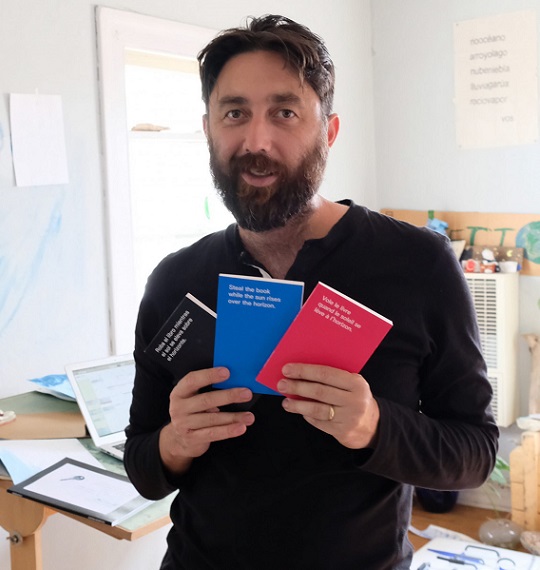David Horvitz (born 1982) is an American artist who uses art books, photography, performance art, and mail art as media for his work. Horvitz is popular for his unique techniques to get his work and memes, viral. One of his most popular meme is “Heads in a Freezer”.
David Horvitz Wiki | Personal Life | Family
David Horvitz was born on 29 March 1982 and he is 40 years old as of 2022. Horvitz is married and also have children but he never disclosed his wife and children names.

| Real Name | David Horvitz |
| Profession | Conceptual Artist |
| Date of Birth | 29 March 1982 |
| Age | 40 years old as of 2022 |
| Nationality | United States |
| Lives in | Los Angeles, California |
David Horvitz’s Work and Carrier
Horvitz uses art books, photography, performance art, watercolor, and mail art as mediums for his work.
Horvit and his art is highly influenced by 1970s conceptual artist Bas Jan Ader . Horvitz’s movie “Rarely Seen Bas Jan Ader Film”,for example, shows a silent black and white clip a few seconds long of a man riding a bicycle into the sea. This evokes the imagery of Ader’s works around the theme of falling and the myth surrounding Ader’s disappearance at sea.
Horvitz’s book “Sad, Depressed People” relates back to Ader’s movie “I’m too sad to tell you” in that all of the stock images Horvitz collected show people with their heads in their hands, as does Ader.
“On Kawara” also has high influence on Horvitz’s work. As David put it “I relate to On Kawara’s work because of its existential and even zen readings.”
In 2009, Horvitz started the “241543903/Head-in-a-Freezer” meme. People were encouraged to take a picture of their heads in a freezer and upload the image with the tag “241543903”. That way everyone could see each other’s images by Googling “241543903”. The meme first gained popularity on Orkut, Google’s social network in Brazil. Horvitz spread the word by sending 100 fliers to a friend in Brazil who handed them out to random young people. It is a rare case where an internet meme was spread through IRL means.

In 2013, Horvitz created The Distance of a Day (two digital videos, 12 minutes each). The Distance of a Day is composed of two phones, placed side by side, playing video recordings of a sunset and a sunrise from opposite points on the globe, near Los Angeles and in the Maldives respectively, recorded at the same moment. The sunset and sunrise were shown side by side on the actual phones (two iPhones) that recorded the scenes. The installation was exhibited at the Art Basel fair in June 2013.
On July 18, 2013, as part of an online one-day project named Artist Breakfast, he “invited artists all over the world to share photos and short descriptions of their morning meals with online audiences throughout the day.”
Horvitz’s Gnomons was exhibited at the New Museum in 2014, featuring four works based on the concept of time. The final work was a performance piece titled Let us Keep our Own Noon, where volunteers rang brass bells in the streets around the museum at solar noon and then walked away from each other until they could not hear other bells. The piece was performed again in 2016 for the 10th anniversary of “Sequences”, Reykjavík‘s biennial festival of “real time art”.
His work also includes “A Wikipedia Reader”, a mind map of artists’ browsing of Wikipedia.
His work Public Access (2010) includes photographs of himself at various public beaches in California which were uploaded to the Wikimedia Commons and then inserted into the Wikipedia pages, and the subsequent reaction of the Commons and Wikipedia communities to his actions. These actions included criticism of the quality and artistry of the images, suspicion of the uploader’s motives, and deletion of most of the images and/or removal of himself from the images. Public Access is “the piece for which he is most well known” and is one of his projects which existed “only for a short time.” Before all items were deleted, Horvitz printed them out, bound them and covertly placed the bound books in the history sections of local libraries along the California Coast.
In 2014, his “somewhere in between the jurisdiction of time” was displayed at Blum & Poe, featuring water collected from the Pacific Ocean between the Pacific and Alaska Time Zones kept in handmade glass bottles and shown in a straight North/South line. Andrew Berardini described the work as creating “some weird uncrossable divide…The mere suggestion of a demarcation forces our moves”.
In 2016, David Horvitz hired a pickpocket to place sculptures in the pockets of attendees of the annual Frieze Art Fair. This was part of “Frieze Projects” a program of 6 commissioned interactive activities at the fair. Said Horvitz, “Imagine how much money is concentrated there, among collectors and galleries—and then there’s this person walking around who’s basically a trained thief,”
His published work includes: Xiu Xiu: The Polaroid Project (2007), Everything that can happen in a day (2010), and Sad, Depressed, People (2012).
He has exhibited at SF Camerawork, the Museum of Modern Art, the New Museum, Tate Modern, and Art Metropole.

Why David Horvitz was Banned by Wikipedia?
In 2013, David was officially banned from Wikipedia by a handful of Wikipedia editors in response to two of his artworks: Public Access(2011) and Mood Disorder (2012). These artworks consisted of photographs of Horvitz, himself standing on beaches in California, and one depicting depression, that were uploaded to Wikipedia.
In response to their verdict, he anonymously and surreptitiously made a photograph of his right hand flipping the editors off and uploaded it to the Wikipedia page for “The Finger”.
This sleight digital intervention is made public for the first time by Horvitz on his twitter, and was previously only known when he presented it in real life in artist lectures. It was kept secret to prevent the photograph’s removal.
(There is a secret message written on his hand, the Italian word for wild boar: cindhiale.) Click here to see the screenshot of that wiki post that was made on 9 December 2021. The original photograph was uploaded on 23 December 2013.
Below is the video of David talking about his work of Mood Disorder in an interview:
Selected Publications & Artwork of David Horvitz
- Lullaby for a landscape (2017)
- Painting the Wind (2016)
- Stolen Spoons (2016)
- Stolen Spoons. Copenhagen: Pork Salad Press. 2015.
- How To Shoplift Books. Portland: Publication Studio. 2014.
- Public Access. Berlin: Motho. 2012.
- Mood Disorder (2012)
- Sad. Depressed. People. Los Angeles: No Documents. 2012.
David Horvitz Social Accounts
For social media accounts of David Horvitz’s follow the links below
| Click here for David Horvitz Instagram Handle |
| Click here for David Horvitz Twitter Account |
Overview
Many of us are curious to know about our favorite Artists’s biography, age, family, affairs, and many more things. This article gives you a glimpse into information related to David Horvitz, Age, Biography, Books, Art and More. We hope you liked the provided information, and let us know if you did.





there is nothing, there is nothing.